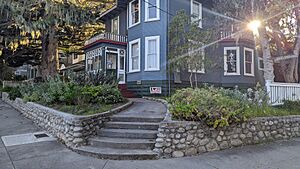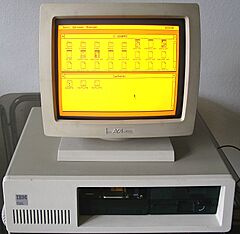Digital Research facts for kids
 |
|

Original headquarters of Digital Research on 801 Lighthouse Ave, Pacific Grove, California. On the sidewalk, to the left, is a commemorative plaque.
|
|
| Private | |
| Industry | Software |
| Fate | Acquired by Novell |
| Founded | 1974 in Pacific Grove, California, United States |
| Founder | Gary Kildall |
| Defunct | 1991 |
| Headquarters |
|
|
Key people
|
|
| Products | Compilers, operating systems, graphical user interfaces |
| Revenue |
|
|
Number of employees
|
|
Digital Research, Inc. (DR or DRI) was a privately held American software company created by Gary Kildall to market and develop his CP/M operating system and related 8-bit, 16-bit and 32-bit systems like MP/M, Concurrent DOS, FlexOS, Multiuser DOS, DOS Plus, DR DOS and GEM. It was the first large software company in the microcomputer world. Digital Research was originally based in Pacific Grove, California, later in Monterey, California.
Contents
History
1974–1979: Founding and incorporation
In 1972, Gary Kildall, an instructor at the Naval Postgraduate School in Monterey, California, began working at Intel as a consultant under the business name Microcomputer Applications Associates (MAA). By 1974, he had developed Control Program/Monitor, or CP/M, the first disk operating system for microcomputers.
In 1974 he incorporated as Intergalactic Digital Research, with his wife handling the business side of the operation. The company soon began operating under its shortened name Digital Research. The company's operating systems, starting with CP/M for 8080/Z80-based microcomputers, were the de facto standard of their era. Digital Research's product suite included the original 8-bit CP/M and its various offshoots like MP/M (1979), a multi-tasking multi-user version of CP/M.
1980–1990: CP/M, CP/M-86
After Microsoft present MS-DOS that was based on CP/M, Digital Research released CP/M-86, which was the first 16-bit system (1981, adapted to the IBM PC in early 1982), which was meant as direct competitor to MS-DOS. There followed the multi-tasking MP/M-86 (1981), and Concurrent CP/M (1982), a single-user version featuring virtual consoles from which applications could be launched to run concurrently.
In May 1983 Digital Research announced that it would offer PC DOS versions of all of its languages and utilities. It remained influential, with US$45 million in 1983 sales making Digital Research the fourth-largest microcomputer software company. Admitting that it had "lost" the 8088 software market but hoped to succeed with the Intel 80286 and Motorola 68000, by 1984 the company formed a partnership with AT&T Corporation to develop software for Unix System V and sell its own and third-party products in retail stores. Jerry Pournelle warned later that year, however, that "Many people of stature seem to have left or are leaving Digital Research. DR had better get its act together."
In a parallel development Digital Research also produced a selection of programming language compilers and interpreters for their OS-supported platforms, including C, Pascal, COBOL, FORTRAN, PL/I, PL/M, CBASIC, BASIC, and Logo.
Digital Research developed CP/M-86 as an alternative to MS-DOS and it was made available through IBM in early 1982. The company later created an MS-DOS clone with advanced features called DR DOS, which pressured Microsoft to further improve its own DOS.
At the time the IBM Personal Computer was being developed, Digital Research's CP/M was the dominant operating system of the day. In 1980, IBM asked Digital Research to supply a version of CP/M written for the Intel 8086 microprocessor as the standard operating system for the PC, which would use the code-compatible Intel 8088 chip. Digital Research, uneasy about the conditions related to making such an agreement with IBM, refused.
Microsoft seized this opportunity to supply an OS, in addition to other software (e.g., BASIC) for the new IBM PC. When the IBM PC arrived in late 1981, it came with PC DOS, an OEM version of MS-DOS, which was developed from 86-DOS, which Microsoft had acquired for this purpose. By mid-1982, MS-DOS was also marketed for use in hardware-compatible non-IBM computers. This one decision resulted in Microsoft becoming the leading name in computer software.
This story is detailed from the point of view of Microsoft and IBM in the PBS series Triumph of the Nerds, and from the point of view of Gary Kildall's friends and coworkers in The Computer Chronicles.
The competition between MS-DOS and DR DOS is one of the more controversial chapters of microcomputer history. Microsoft offered better licensing terms to any computer manufacturer that committed to selling MS-DOS with every system they shipped, making it uneconomical for them to offer systems with another OS, since the manufacturer would still be required to pay a license fee to Microsoft for that system. This practice led to a US Department of Justice investigation, resulting in a decision in 1994 that barred Microsoft from "per-processor" licensing.
Successive revisions of Concurrent CP/M incorporated MS-DOS API emulation (since 1983), which gradually added more support for DOS applications and the FAT file system. These versions were named Concurrent DOS (1984), with Concurrent PC DOS (1984) being the version adapted to run on IBM compatible PCs.
In 1985, soon after the introduction of the 80286-based IBM PC/AT, Digital Research introduced a real-time system, initially called Concurrent DOS 286.
Other single-user operative systems were launched: DOS Plus (1985) and DR DOS (1988). The latter system was marketed as a direct MS-DOS/PC DOS replacement with added functionality. In order to achieve this, it gave up built-in support to run CP/M applications and was changed to use DOS-compatible internal structures. It became a successful product line in itself.
Graphics Environment Manager (1985)
In 1985 Digital Research also produced a microcomputer version of the GKS graphics standard (related to NAPLPS) called GSX, and later used this as the basis of their GEM GUI. Less known are their application programs, limited largely to the GSX-based DR DRAW and a small suite of GUI programs for GEM. After the development of GEM, Microsoft introduced Windows 1.0.
Digital Research (and later its successor Caldera) accused Microsoft of announcing vaporware versions of MS-DOS to suppress sales of DR DOS.
FlexOS, Concurrent DOS XM and Concurrent DOS 386
Concurrent PC DOS later evolved into the modular FlexOS (1986). This exploited the greater memory addressing capability of the new CPU to provide a more flexible multi-tasking environment. There was a small but powerful set of system APIs, each with a synchronous and an asynchronous variant. Pipes were supported, and all named resources could be aliased by setting environment variables. This system was to enjoy enduring favour in point-of-sale systems.
Other successors of Concurrent DOS were Concurrent DOS XM (1986) and the 32-bit Concurrent DOS 386 (1987).
1990 and 1991: Multiuser DOS
In 1991 DR presented Multiuser DOS. Digital Research's multi-user family of operating systems was sidelined with the previous single user operative systems.
In one beta release of Windows 3.1, Microsoft included hidden code (later called the AARD code) that detected DR DOS and displayed a cryptic error message. Although this code was not enabled in the final version of Windows 3.1, it gave the wrong impression that DR DOS was incompatible with MS-DOS and Windows among testers. These activities came to light when the discovery process of the subsequent lawsuit uncovered emails from senior Microsoft executives that showed this time bomb plant was part of a concerted program to drive Digital Research out of the PC operating systems business.
1991–2014: Acquisition by Novell
Digital Research was purchased by Novell for US$80 million in 1991, primarily for Novell to gain access to the operating system line. FlexOS, this operative system had already been adopted as the basis for the following systems:
- Siemens S5-DOS/MT,
- IBM 4680 OS
- 4690 OS.
DR Multiuser DOS was also evolved further into independent products as the follow: Datapac System Manager, IMS REAL/32 and REAL/NG. Novell continued development of the DR DOS line led to non-DRI products such as Novell PalmDOS, Novell DOS, Caldera OpenDOS and Dell RMK. Novell sold DR-DOS product line off to Caldera on 23 July 1996, after it approached Novell looking for a DOS operating system to bundle with its OpenLinux distribution.
Caldera
Caldera (company)
Notable employees
Several notable employees worked at Digital Research, some of which later made important contributions to the IT industry, such as:
- Gary Kildall, Ph. D. in Computer Science.
- Kathryn Strutynski, master's degree in computer programming, whon was responsible of VM (operating system) at the Naval Postgraduate School, she and Kildall adapted IBM operative system to create CP/M, the first microcomputer operative system, then left NPS and became the fourth Digital Research employee.
- Gordon Eubanks
- Tom Rolander
- Lee Jay Lorenzen
- Don Heiskell
- John Meyer
- and Edward R. McCracken.
Acquisitions
- Compiler Systems, Inc. (1981) for CBASIC
- MT MicroSYSTEMS, Inc. (1981) for Pascal/MT+
See also
- Multiuser DOS Federation
- Novell Digital Research Systems Group
- Caldera Digital Research Systems Group


